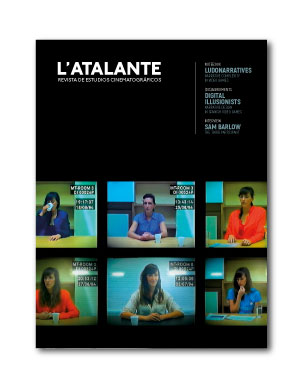The Promised Land in Contemporary Video Games: A Myth Analysis of 'Bioshock Infinite' and 'Death Stranding'
Published 2021-01-30
Keywords
- Video games,
- Myth,
- Promised Land,
- Fundation,
- Myth Analisys
- Mythemes. ...More
How to Cite
Copyright (c) 2021 L'Atalante. Journal of film studies

This work is licensed under a Creative Commons Attribution-NonCommercial-NoDerivatives 4.0 International License.
Abstract
The traditional creation of nations and states has made use of the Promised Land myth as a means of political and religious legitimation. The purpose of this article is to compare how this myth has been reinterpreted in contemporary video games. To this end, the mythemes of the stories of Moses and Aeneas serve as the basis for a myth analysis of two games dealing with foundational experiences: Bioshock Infinite and Death Stranding. The findings reveal the persistence of the mytheme structure of the classical myth, although with mutations of its motifs to convey the promise of the techno-religion and the sceptical post-modern hero.
Downloads
References
Bachelard, G. (1960). <em>La poétique de la rêverie</em>. París: Presses universitaires de France.<br>
Barthes, R. (2012). <em>Mitologías</em>. Madrid: Siglo XXI.<br>
Burke, E. (1998). <em>Philosophical Enquiry into the Origin of Our Ideas of the Sublime and Beautiful</em>. Nueva York: Penguin.<br>
Campbell, J. (2014). <em>Los mitos. Su impacto en el mundo actual</em>. Barcelona: Kairós.<br>
Campbell, J. (2015). <em>El héroe de las mil caras. Psicoanálisis del mito</em>. México: Fondo de Cultura Económica.<br>
Cassar, R. (2013). God of War: A Narrative Analysis. <em>Eludamos. Journal for Computer Game Culture</em>, <em>7</em>(1), 81-99. Recuperado de https://www.eludamos.org/index.php/eludamos/article/view/vol7no1-5/7-1-5-html <br>
Durand, G. (1982). <em>Las estructuras antropológicas de lo imaginario</em>. Madrid: Taurus.<br>
Durand, G. (1993). <em>Las estructuras antropológicas de lo imaginario</em>. Barcelona: Anthropos.<br>
Durand, G. (2012). La mitocrítica paso a paso. <em>Acta Sociológica</em>, <em>57</em>, 105-118. http://dx.doi.org/10.22201/fcpys.24484938e.2012.57.29762<br>
Eliade, M. (1999). <em>Mito y realidad</em>. Barcelona: Kairós.<br>
Eliade, M. (2000). <em>Aspectos del mito</em>. Barcelona: Kairós.<br>
Freud, S. (2013). <em>La interpretación de los sueños</em>. Madrid: Akal.<br>
Galanina, E., Salin, A. (2017). Mythology Construction in Virtual Worlds of Video Games. En VV. AA., <em>4</em>th<em> International Multisciplinary Scientific Conference on Social Sciences and Arts SGEM 2017 Conference Proceedings</em> (pp. 507-514). Bulgaria: SGEM. http://dx.doi.org/10.5593/sgemsocial2017/22/S09.067 <br>
Galanina, E., Baturin, D. (2019). The Trace of Archaic Myth in Video Games. <em>The European Proceedings of Social and Behavioural Sciences</em>, <em>76</em>, 3660-3667. https://doi.org/10.15405/epsbs.2019.12.04.492 <br>
Galloway, A. (2006). <em>Gaming: Essays on Algorithmic Culture</em>. Minnesota: University of Minnesota Press.<br>
García Gual, C. (2017). <em>Diccionario de mitos</em>. Madrid: Turner.<br>
Garin Boronat, M. (2009). Mitojuegos. Sobre el héroe y el mito en el imaginario Nintendo. <em>Revista Internacional de Comunicación Audiovisual, Publicidad y Literatura</em>, <em>1</em>(7), 94-115. Recuperado de http://www.revistacomunicacion.org/pdf/n7/articulos/a7_Mitojuegos_Sobre_el_heroe_y_el_mito_en_el_imaginario_Nintendo.pdf <br>
Gutiérrez, F. (2012). La mitocrítica de Gilbert Durand: teoría fundadora y recorridos metodológicos. <em>Théleme. Revista Complutense de Estudios Franceses</em>, <em>27</em>, 175-189. http://dx.doi.org/10.5209/rev_THEL.2012.v27.38931 <br>
Guyker, Jr., R. W. (2016). <em>Myth in Translation: The Ludic Imagination in Contemporary Video Games</em>. Tesis Doctoral. Ann Arbor: Pacifica Graduate Institute. Recuperado de https://pqdtopen.proquest.com/doc/1785853075.html?FMT=AI <br>
Jung, C. G. (2009). <em>Arquetipos e inconsciente colectivos</em>. Barcelona: Paidós.<br>
Lévi-Strauss, C. (2009). <em>Antropología estructural</em>. Madrid: Siglo XXI.<br>
Losada, J. M. (2015). Estructura del mito y tipología de su crisis. En J. M. Losada y A. Lipscomb (eds.), <em>Myths in Crisis: The Crisis of Myth</em> (pp. 33-62). Newcastle: Cambridge Scholars Publishing.<br>
Mellado Rodríguez, J. (2006). Moisés y Rómulo y Remo: la historia y el mito. <em>Veleia</em>, <em>23</em>, 25-39. Recuperado de https://ojs.ehu.eus/index.php/Veleia/article/view/2842 <br>
Mosco, V. (2004). <em>The Digital Sublime. Myth, Power and Cyberspace</em>. Cambridge: MIT Press.<br>
Navarro Remesal, V. M. (2016).<em> Libertad dirigida. Una gramática del análisis y diseño de videojuegos</em>. Santander: Shangrila.<br>
Noble, D. F. (1997). <em>The Religion of Technology. The Divinity of Man and the Spirit of Invention</em>. Nueva York: Penguin.<br>
Noble, D. F. (2005). <em>Beyond the Promised Land. The Movement and The Myth</em>. Ontario: Between the Lines.<br>
Pérez Latorre, O., Oliva, M. (2019). Video Games, Dystopia and Neoliberalism: The Case of <em>Bioshock Infinite</em>. <em>Games and Culture</em>, <em>14</em>(7-8), 781-800. https://doi.org/10.1177/1555412017727226<br>
Planells de la Maza, A. J. (2015a). <em>Videojuegos y mundos de ficción. De Super Mario a Portal</em>. Madrid: Cátedra.<br>
Planells de la Maza, A. J. (2015b). Mundos posibles, grupos de presión y opinión pública en el videojuego Tropico 4. <em>Trípodos</em>, 37, 167-181. Recuperado de http://www.tripodos.com/index.php/Facultat_Comunicacio_Blanquerna/article/view/258<br>
Planells de la Maza, A. J. (2018). La semilla digital en los videojuegos: los argumentos universales como marcos ludoficcionales. <em>Caracteres. Estudios culturales y críticos de la esfera digital</em>, <em>7</em>(1), 450-471. Recuperado de http://revistacaracteres.net/wp-content/uploads/2018/05/Caracteresvol7n1mayo2018-semilla.pdf <br>
Rank, O. (1991). <em>El mito del nacimiento del héroe</em>. Barcelona: Paidós.<br>
Sadin, E. (2018). <em>La silocolonización del mundo. La irresistible expansión del liberalismo digital</em>. Buenos Aires: Caja Negra Editora.<br>
Todor, A. (2010). <em>Video Games as Myth Reconstructions</em>. Proyecto de Fin de Grado. Brasov: University of Brasov. <br>
Venegas, A. (2017). <em>Bioshock y el alma de Estados Unidos</em>. Sevilla: Héroes de Papel.<br>
Wysocki, J. (2018). Critique with Limits—The Construction of American Religion in <em>BioShock: Infinite</em>. <em>Religions</em>, <em>9</em>, 1-14. https://doi.org/10.3390/rel9050150</p>

